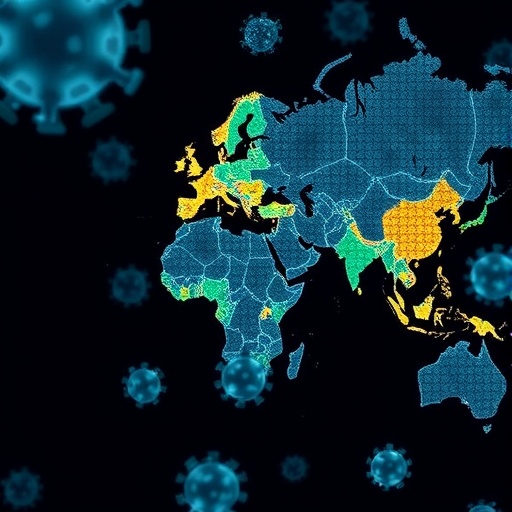In a groundbreaking study published in the latest issue of npj Viruses, researchers have unveiled new insights into the antigenic landscape of Influenza A virus neuraminidase (NA) through a refined application of the kinetic MUNANA assay. This investigative effort sheds light on previously elusive functional epitopes targeted by antibodies, paving the way for enhanced antiviral strategies and vaccine designs aimed at curbing the global burden of influenza infections.
Influenza A virus remains a persistent threat to public health, with its capacity for rapid evolution and antigenic drift undermining the efficacy of current vaccines. Central to the viral life cycle is neuraminidase, a surface glycoprotein whose enzymatic activity facilitates viral egress from infected host cells by cleaving sialic acid residues. Due to its essential role in viral replication and release, NA represents a prime target for both therapeutic inhibition and immune recognition.
Historically, much vaccine development has concentrated on hemagglutinin (HA), another prominent surface protein responsible for host cell attachment. However, recent shifts in influenza research emphasize the importance of NA-targeted immunity, acknowledging its critical contribution to viral fitness and the protective potential of anti-NA antibodies. The present study leverages the kinetic MUNANA assay to dissect the interaction dynamics between neuraminidase and monoclonal antibodies, offering a granular view of functionally relevant epitopes.
The MUNANA assay utilizes the fluorogenic substrate 2’-(4-methylumbelliferyl)-α-D-N-acetylneuraminic acid, which, upon cleavage by active neuraminidase, releases a fluorescent moiety detectable in real time. By adapting the assay to measure kinetic parameters such as enzyme velocity and substrate turnover in the presence of different antibodies, the researchers were able to quantify inhibitory effects with unprecedented precision. This approach circumvents limitations inherent to traditional endpoint assays, providing dynamic, time-resolved data indicative of antibody functionality.
The study cohort comprised a diverse set of monoclonal antibodies raised against distinct neuraminidase epitopes from various Influenza A strains. Through systematic kinetic analyses, the researchers identified key antigenic regions where antibody binding effectively diminished enzymatic activity, correlating inhibition profiles with epitope localization inferred from complementary structural biology data. Such correlations elucidate the molecular underpinnings of antibody-mediated neutralization and offer valuable biomarkers for vaccine antigen selection.
Intriguingly, the kinetic MUNANA assay revealed differential inhibitory potency among antibodies that target superficially similar epitopes, suggesting subtle nuances in the mode of epitope engagement govern functional outcomes. These nuanced interactions imply that antibody binding affinity alone does not fully dictate neutralization capacity; rather, the spatial orientation and dynamics of antibody-NA interfaces are crucial parameters. This insight advances the conceptual framework for designing NA-directed immunogens and therapeutic antibodies.
The implications of these findings extend beyond fundamental virology into applied domains, particularly in improving the composition and efficacy of seasonal influenza vaccines. Current vaccines often underestimate NA immunogenicity, failing to robustly stimulate protective anti-NA responses. By delineating epitopes that are both functionally significant and broadly conserved, the study provides a rational basis for incorporating such determinants into next-generation vaccines aimed at eliciting durable, cross-protective immunity.
Moreover, the kinetic MUNANA assay platform established in this research offers a scalable and sensitive method for evaluating candidate antibodies during the drug development pipeline. Given that neuraminidase inhibitors remain a frontline antiviral class, understanding the interplay between therapeutic compounds and antibody-mediated inhibition could inform combination strategies to mitigate resistance and enhance clinical outcomes.
The study further emphasizes the potential of targeting conformational epitopes that may be masked or poorly represented in conventional antigen preparations. Since the native quaternary structure and oligomerization state of neuraminidase influence epitope presentation, the kinetic assay’s ability to assess activity in near-physiological contexts represents a significant methodological advance.
As Influenza A virus continues to challenge existing public health measures with its seasonal variability and pandemic potential, insights derived from precise functional assays like the kinetic MUNANA assay are invaluable. They complement advances in structural virology and immunology, collectively steering influenza research toward more effective prophylactic and therapeutic interventions.
This investigation also highlights the importance of interdisciplinary integration, combining biochemical kinetics, immunological specificity, and virological relevance. Such comprehensive perspectives are essential to tackling the complex mechanisms underlying viral pathogenesis and immune evasion.
Future research directions may build on these findings by exploring antibody combinations targeting multiple epitopes to maximize synergistic inhibition of neuraminidase. Additionally, longitudinal studies assessing how epitope recognition profiles evolve with virus antigenic drift could inform adaptive vaccine strategies capable of outpacing viral mutation.
In conclusion, the kinetic MUNANA assay serves as a powerful tool that transcends traditional static measurement paradigms, illuminating the dynamic nature of antibody-viral protein interactions. The detailed mapping of functionally relevant epitopes unveiled in this work propels the field toward more precise immunological interventions, holding promise for reducing influenza’s global impact through improved vaccine efficacy and antiviral therapeutics.
Subject of Research: Functional characterization of antibody epitopes on Influenza A virus neuraminidase using the kinetic MUNANA assay.
Article Title: Kinetic MUNANA assay reveals functionally relevant antibody epitopes on Influenza A virus neuraminidase.
Article References:
Smirnov, I.V., Besavilla, D.F., Schön, K. et al. Kinetic MUNANA assay reveals functionally relevant antibody epitopes on Influenza A virus neuraminidase. npj Viruses 3, 40 (2025). https://doi.org/10.1038/s44298-025-00123-y
Image Credits: AI Generated




